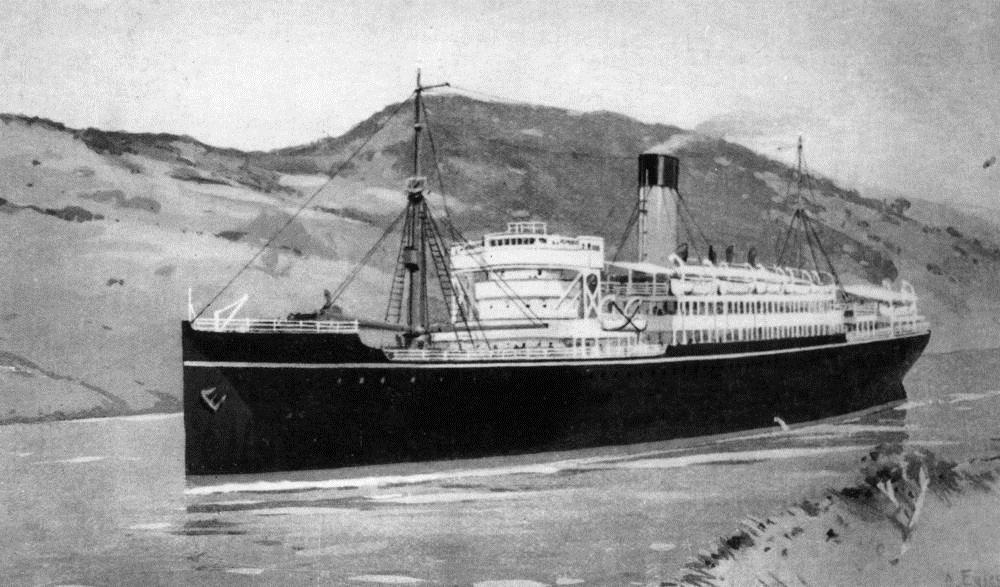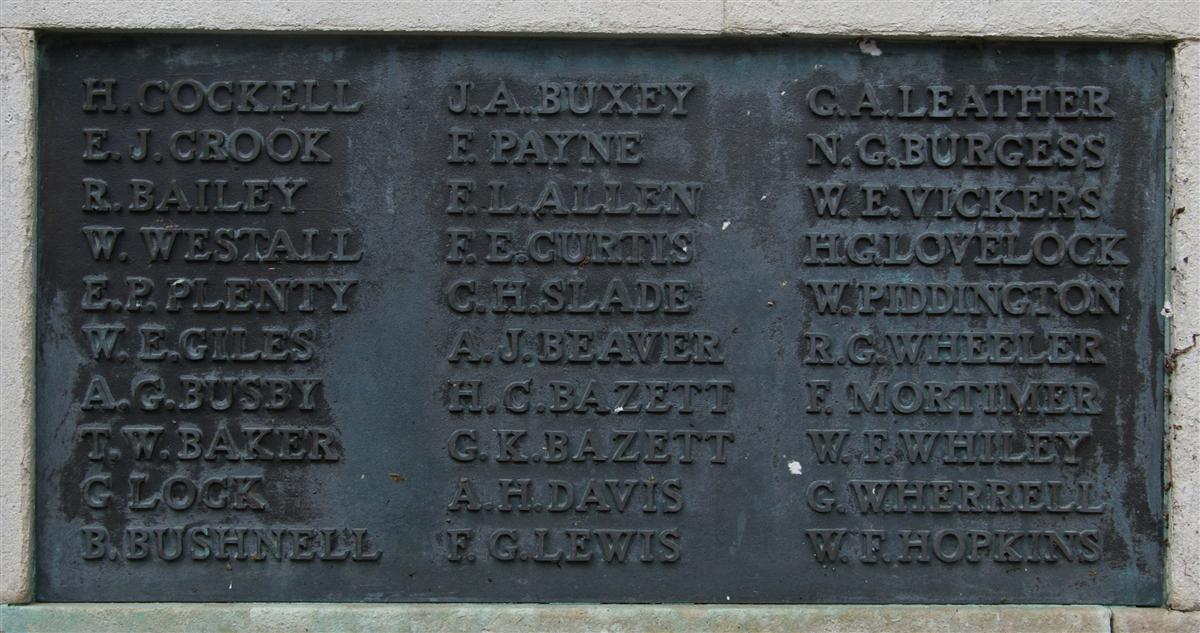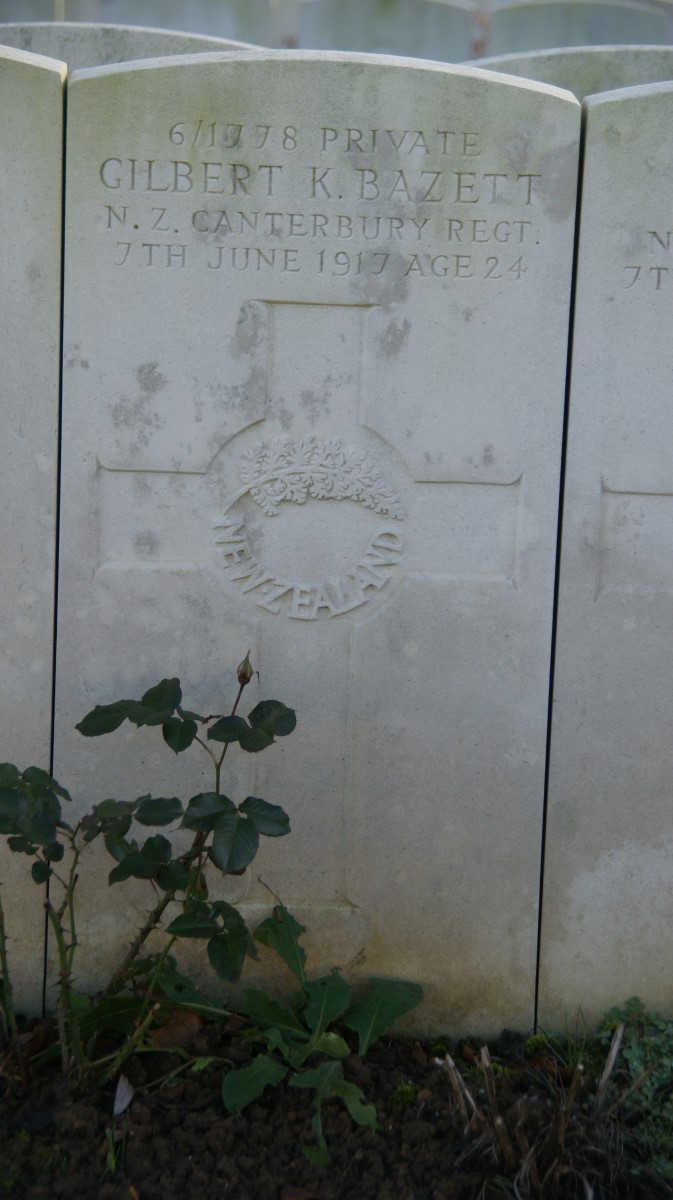Gilbert Knowles Bazett
Private 6/1778 Gilbert Knowles Bazett, 2nd Battlion, Canterbury Regiment, NZEF
Gilbert Bazett was born in Newbury on 23 July 1893, the fourth son of Alfred Campbell Bazett and his wife Jane Elizabeth née Knowles. His father was a well-known local solicitor who had come to Newbury in the late 1870s running his business from 41 Cheap Street and living in Chilton Lodge, Speen. Alfred died aged only 46 in 1898, leaving his wife to raise their large family. Fortunately he left them reasonably well provided for with, what was then the considerable sum of £2,632 5s (the value today would be somewhere in excess of £500,000).
Warren H Pitman was brought into the soliciter's business; he added his name to Bazett's to establish the long lasting Pitman Bazett partnership. The firm outlasted both founders, moving eventually to 34 London Road, Newbury; in 2001 the name disappeared when the firm merged with Penningtons (later to merge with Thomas Eggar). Pitman's was not a complete takeover or buy-out; the Bazett family remained associated with the firm for many years, notably through Gilbert's brother Frank Doveton Bazett.
 SS Tainui (Queensland State Library) |
After completing his schooling Gilbert entered the motor trade as an apprentice in Fulham. However, it seems that motor trade did not suit and that Gilbert elected (or was elected) to go out to New Zealand to work on a fruit farm owned by Francis Knowles, presumably a relative of his mother. He left London on 30 January 1913 on the SS Tainui. When he arrived in New Zealand he gained something he would not have had in England, the right to vote, he appears of the electoral roll in 1914 living in Pangatora.
On 7 January 1915 Gilbert signed up with the New Zealand Army and was soon assigned to the Canturbury Infantry Regiment. After a period of training he joined 2,253 other men aboard three ships (Wilochra, Knight Templar and Waitomo) that set sail on 17 April 1915, bound for the Mediterranean with the 4th reinforcement for the New Zealand Expeditionary Force. Eight days later, on 25 April (celebrated ever since as ANZAC Day) the first Allied troops landed on the beaches of Gallipoli - the reinforcements were going to be needed.
On 8 June Gilbert joined his battalion, the 2nd Battalion, Canterbury Regiment and would soon have been involved in the action. Almost two months later on 7 August he was wounded, shot in the leg, and evacuated to a hospital ship (arriving on the ship over a day later, on 9 August). Five days later he was in hospital in Cairo.
Newbury Weekly News, 9 September 1915 – Local War Notes
The Mayor of Newbury’s youngest brother, Pte Gilbert K Bazett, has been wounded in the great battle at Suvla Bay. He was in New Zealand at the outbreak of war, and endeavourse to join the first Colonial contingent, but was unable to do so. He was more successful with the second force and went straight to the Dardanelles. He is now in hospital in Cairo.
By 25 September he was sufficiently recovered to return to duty at a base depot in Mustapha while he waited for a return to Gallipoli; he didn't have a long wait and embarked on the SS Maniton on 2 October rejoining his unit at Mudros on the Greek island of Lemnos. It seems that he was not deemed fully fit for he remained in the safety of Mudros as part of the base detail. Whether the precaution proved to be a wise one is unclear, but Gilbert was soon (29 December) back in hospital, this time with mumps and dysentry - categorised as 'dangerously ill'. On 8 January 1916 he was removed from the dangerously ill list but was, nevertheless in hospital and a convalescent home until 25 March. However, he was deemed fit enough to rejoin his unit and embark for France on 8 April. His journey was not without incident as he found himself in trouble for 'refusing to rejoin his carriage' on 16 April earning himself 14 days confined to barracks (one can't help thinking that 'confined to barracks' would be a treat for the men in the trenches). No doubt the sentence was served with his unit wherever they might be.
 Gilbert's name on Newbury War Memorial. |
In August Gilbert's military career took a strange turn. As a tall man (5ft 11½in) he cannot have been a obvious choice to become a tunneller, but that is exactly what occured and he was attached to the 1st Australian Tunnelling Company. The much acclaimed book by Sebastian Faulks and the recent TV series 'Birdsong' has highlighted the role played by tunnellers in the trench warfare of WW1. Coincidentally, Sebastian Faulks' father, Peter, was a partner with Gilbert's brother, Frank, in Pitman & Bazett, the company founded by Gilbert's father.
If he was lucky he would have have been digging dugouts, shelters for the troops from the ever-present threat of enemy shellfire. If he was not so lucky he would have been tunnelling towards enemy lines, hopefully reaching a predetermined point where explosives would be placed, eventually to be used to destroy an enemy position above. As well as the worry about the tunnel collapsing there was the constant threat that enemy tunnellers would intercept the Allied tunnel, if they did deadly underground fighting would follow, or the enemy would exploe their own mine alongside the digging, perhaps burying the Allied tunnellers alive as the blast collapsed the workings. At this date the Company was tunnelling at Ploegsteert (Plugstreet as if was known to the Allied troops), Prowse Point and Bullring before getting involved with the preparation of dugouts at Hill 63 later in the month. In November, after a short break digging dugouts in Ypres (Ieper) the Company moved to Hill 60 on the Messines Ridge, where several mines were being dug, planned to be exploded under German lines as a precursor to a major Allied offensive the next year. Progress was slow, a few feet a day; their war diary contains short entries detailing the daily progress and simple statements such as 'enemy fairly quiet in mining system' (15 November). Towards the end of the month there are signs of enemy tunnelling as sounds of chiselling and nails being driven into wood are heard on the 'geophone' from 50 feet or so away from one of the Allied tunnels.
In conditions like this nerves of steel were required - it seems that Gilbert either lacked them or possessed them in abundance for he went missing (AWOL) for a few days, between 30 September and 4 October, before being caught by the MPs in possession of 'an irregular pass'. He was either attempting to escape from the terror or trying to pull a fast one and get a bit of extra R&R with his dodgy pass. Either way he was sentenced to 120 hours detention, forfeited four days pay, and was soon back in the tunnels.
 Gilbert's grave at Bailleul. |
After November spent in the Hill 60 tunnels he was 'repatriated' when he was transferred from the 1st Australian Tunnellers to the New Zealand Tunnelling Company. These men were involved in a massive underground operation in what was known as the Ronville system. Huge natural caverns were expanded and extended towards the enemy lines. Three massive mines were to be prepared as well as space to house tens of thousands of Allied troops. It is not surprising that they drafted in extra troops to help the experienced tunnellers (often miners in civilian life). On 9 April the Battle of Arras was launched, the mines were blown and the work of the tunnellers was over in this area. No longer requiring the extra help Gilbert seems to have been surplus to requirements and he returned to the Canterbury Regiment on 24 April.
It transpired that he would probably have been better off underground - six weeks after returning to his battalion, on 7 June 1917, he was wounded, this time in the arm. While this doesn't sound too serious it turned out to be a fatal wound.
Gilbert was evacuated in a Field Ambulance to No 2 Australian Casualty Clearing Station at Trois Arbres, near the small French town of Bailleul. Gilbert died there later that day.
Newbury Weekly News, 21 June 1917 – Died of Wounds
BAZETT – On June 7th, 1917, died of wounds received in action that day in France, Gilbert Knowles,Pte New Zealand Force, youngest and dearly loved son of Mrs Bazett, of 12, St Matthews Gardens, St Leonard’s-on-Sea, and the late A Campbell Bazett, of Newbury, aged 24.
His body was buried in Bailleul Community Cemetery Extension, plot III.C.270.
 Gilbert's name on Newbury War Memorial, immediately below his brother Hugo. (lower middle) |
He is commemorated on Tablet 9 of the Newbury Town War Memorial as is his eldest brother Hugo.
The second brother, Frank, was mayor of Newbury in 1916 when he too was called up to serve. He earned an MC and rose to the rank of Captain in the Royal Berkshire Regiment before returning to Newbury to carry on his father's firm of solicitors. During WW2 he was once again mayor of Newbury.

Find a memorial :
| Died this day: | |
| 14 January 1946 | |
| Henry Charles Waite | |
| Upper Basildon |

Like this site? Show your appreciation through a donation to a great charity.